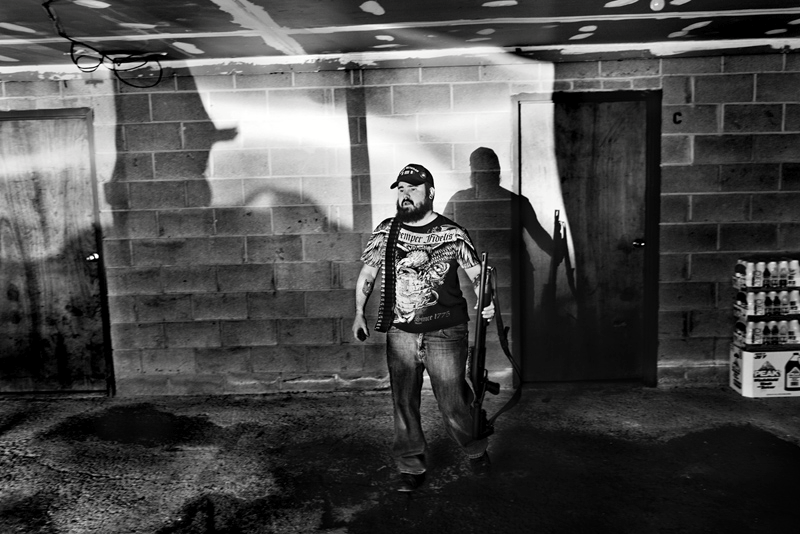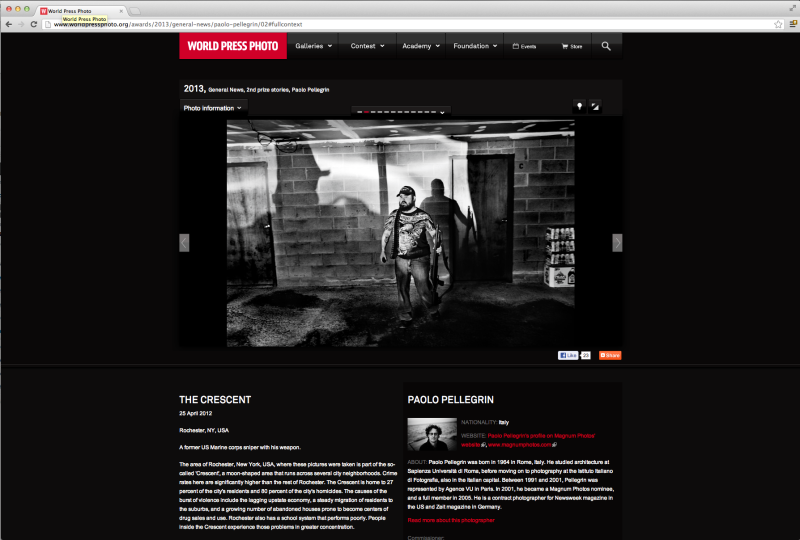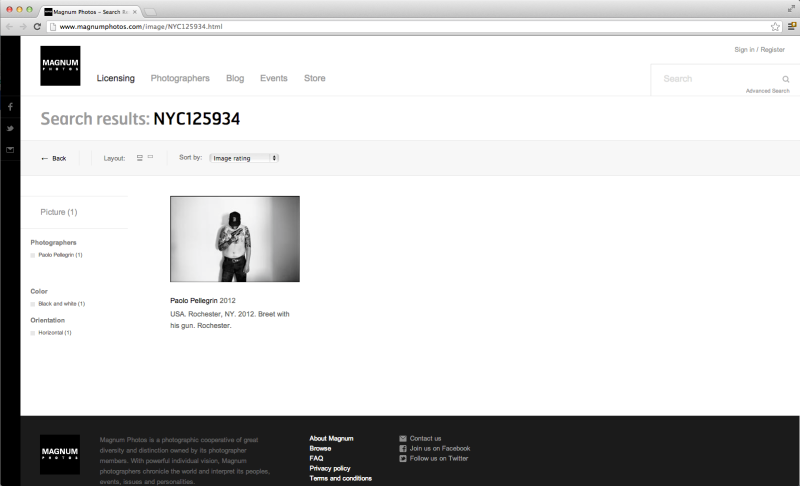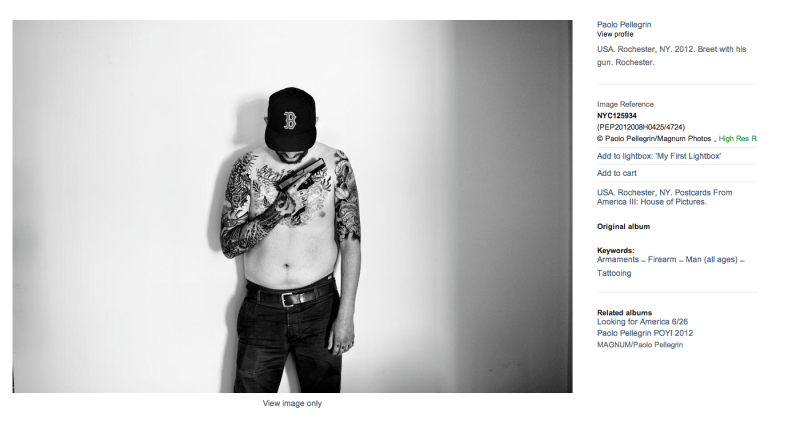
“A former US Marine corp sniper with his weapon. Rochester, NY. USA 2012”
– Paolo Pellegrin
Full disclosure, I am close friends with Shane Keller, the man pictured above. We served in the same Combat Camera unit in the Marine Corps from 2004 to 2008 and deployed to Iraq together.
I normally don’t write posts like this (this is actually the first time) but this situation is very close to me. I was out of town for the entire weekend without computer access so I was unable to write anything down until now. Even with no computer access I was keeping constant tabs on the situation via my iPhone and iPad, and I spoke with Mr. Keller multiple times. Many points and issues have arisen in the discussions that have taken place among the comment sections of various articles on the situation as well as on different Facebook groups. Almost everything about this controversy has been brought up, but there has been one thing that hasn’t and it is my main issue with the whole thing.
Is purposely omitting facts considered lying?
From the beginning of my photography career and education I have always been taught that captions are extremely important to prevent an image from being taken out of context and used incorrectly. This is where the “who, what, where, when, and why” comes into play and why it is so important. The importance was jammed in everywhere from the military photography school at DINFOS to the photojournalism program at the Corcoran College of Art and Design. Every shooting internship I had demanded accurate captions with each of my images or else they would have been spiked. Captions go hand-in-hand with our images as Photojournalists and a caption can either make a mundane image dramatic and a dramatic image mundane. It is important to remember this as Photojournalists because the main tenet of our job and industry is to tell the truth above all else. If you start to weigh dramatics more than truth in what you do, then you are no longer being what a Photojournalist should be.
Now let’s look at the Image of Shane that Paolo Pellegrin entered into World Press Photo and Picture of the Year International.
When I first came across that image in the photo story, I didn’t recognize Shane. Part of that was because I haven’t seen him face to face in a couple of years, but also because I never expected him to show up in a photo essay on this topic. I first thought the subject was either an undercover cop, a thug, a drug dealer, or a vigilante, all logical interpretations when viewing the image. If you want clarification on how the subject is involved in the story then you go to the caption, but the provided caption offers next to nothing when it comes to context so the viewers are left to their own interpretations.
This is where my issue comes up. Mr. Pellegrin had every chance to get the correct caption information and even admits that at one point he had it, but then forgot. He knew Shane was not a cop or a drug dealer or a criminal yet offers no clarification for the viewer. In his reply to the original allegations he said he believed that because Shane kept guns to protect his house and home from criminals, he was involved in the greater picture. That assumption about Shane is partially true and including that information in the caption information would have clarified things a good bit but that’s the problem. He was intentionally vague and omitted information about Shane because the information would have arguably made the image less dramatic.
Now, I want to bring another image into question that wasn’t included in the story submitted to the competitions but is a part of the greater body of work shot for the “Crescent” story. It is available for purchase by clients on the MAGNUM website.
Take a moment and really look at that picture. The caption is exactly as it is presented with the photo on the website. Form your own interpretation before reading on.
The man pictured is Brett Carlsen, the RIT student who was assisting Mr. Pellegrin on the story and the person who put Mr. Pellegrin in touch with Shane. The way this image came about was mentioned by Mr. Keller in the original BagNews story about the issue at hand. Not only does the caption misspell Brett’s name but it identifies the gun as his when it is actually Mr. Keller’s pistol and Mr. Pellegrin had asked Mr. Carlsen to pose for the photo.
Does this change your interpretation of the image? Does it significantly change it?
This is undeniably a portrait. That much is clear but what is unclear in its presentation is what it’s a portrait of. Is it a portrait of a gang member and his gun? That’s what I first thought. Once you know more information about the photo you know it’s not, but the only information you are presented with leads you to believe it is something that it is not. Obviously the image is much less dramatic once all the facts are presented.
This photo is being presented in almost a malicious way for a few reasons. For one, it presents Mr. Carlsen as a gang member. It also presents him as an illegal gun owner because it is not his gun. If somehow he came under investigation for a crime where ownership of a gun was important and this image surfaced, then his innocence would be questioned because it is being presented in a journalistic setting with a journalistic intent and truth is the main staple of journalism, both written and photographic. Now in a court of law it would be found to be false and a lie; but if a court of law would come to that conclusion, shouldn’t we, the journalism community and industry, do so first?
There are no laws that govern how the news and journalism operates. The only reason the public trusts journalists to tell the truth is because we hold ourselves to exacting standards of truth. The moment we start to no longer hold ourselves to our own high standards the public has no reason to believe the stories we report. They will begin to question even the most important issues because they have no idea if they are being shown the truth or propaganda.
The question I want you to ask yourself during and after this situation is this:
Is purposefully omitting information in order to guide the viewer into coming to a more dramatic conclusion the same as lying?
I welcome comments and discussions bellow.
****UPDATE****
In the past day some developments have come about from this whole controversy. World Press Photo and Pictures of the Year International have both responded to the situation and have decided to let the awards stand for Mr. Pellegrin
In contrast, Magnum has removed both images from their website and they are no longer for sale as part of “The Crescent” project.
Even though the contests have failed to defend the ethics of the whole situation, maybe Magnum will be more vigilant in the future.




Attempts to mislead the viewer are lies if the photo is supposed to be news but if the work is presented as photographic art they aren’t necessarily lies.
Sadly the importance of “who, what, where, when, and why” is lost on many photographers, though it really should be part of any photojournalists DNA. I run a tiny picture agency in Norway, but at times we handle the work of some fairly big names. And it never seizes to amaze me how little importance some PJs place on captions.
Yes. That is the answer to your question. Yes. It is lying. It is misleading. How can we be debating this?
I think you are making a lot of assumptions yourself. The caption reads Breet (misspelled) with his gun. It does not claim that he is a gang member (your assumption), and while It doesn’t say Brett is holding a friend’s gun, can one really assume he is an illegal member. There have been thousands of photos taken of people who own guns and lots of them look like this so just because the guy has tattoos, is it right to assume he is a gang member? And you make a judgement of someone who you gave not talked to by calling them malicious. you only talked to your buddy who is, of course, going to give you only his side of the story. If these students were journalism students (or photojournalism students), why did they agree to pose…they knew what they were doing and that Mr. Pellegrin was photographing them. They should not act like innocent little lambs because they agreed to be photographed. I would also add that we are, to some degree, discussing how Americans see things and how Europeans see things. Is one more right than the other? I can’t say but I agree with another commenter that the work leans more toward making an artistic rather than a journalistic statement. It is lamentable that Mr. Pellegrin didn’t give more information but it seems that lots of people who really know nothing about it are willing to add plenty along with judgement. I do agree that most photojournalists—including American ones—fail to add enough information and I drive this home when I teach to the point that I get tired of hearing myself. I would also like to point out, one more time, that the writers of the Bag News articles failed to contact Mr. Pellegrin BEFORE they published their article…and some of them teach journalism! At this point, perhaps there are no innocent parties but as we all know, if we are thinkers on any level, how we see things, how we experience them, HOW WE REMEMBER them depends on our points of view, how much we were listening, how much someone was talking, as much as anything else. Science has shown that each time we recall a memory, we recall it differently and so perhaps no one’s memory of these accusations is serving them very well.
You seem to be defending Mr. Pellegrin. If for a moment we exclude Shane’s name from the discussion and ignore the fact he is ‘American’ in order to negate your European prejudices. Let us just state the facts. The individual in the picture is not a Military Sniper as was stated. The photo was also not taken in the location stated. It very straightforward really. Again I’m unclear as to how you can defend Mr. Pellegrin.
Of course it is lying. It is supposed to be a FACTUAL NEWS story because it was presented as such…..not purely a work of art. A work of art can be anything the artist wants. Photojournalism doesn’t have this limitless ability, the element of truth, of the “reveal”, is essential.
Pingback: >Re: PHOTO » Blog Archive » More on World Press Photo
This whole episode involving Paolo Pellegrin and the intent of his photo story hits at the heart of journalism. You never lie about the circumstances of a photograph. It is hard to understand why so many people are defending him. I was an ardent admirer of his body of work until now. I find the circumstances of this story unnerving and deceitful. If a photographer wants to be an artist, be an artist and make up everything you want. But, if you are a photojournalist, there are strict rules. There can be no manipulation of people so your story is more dramatic. You don’t plagiarize from the New York Times. His entries in World Press were in the General News story category. Maybe he should rethink his work. Or rework the story so it is a Portrait Series. Or perhaps, as an answer to this and the continued misrepresentation of news photographs, maybe World Press should institute a Fiction category. It’s my view that all of the awards involving this story should be rescinded.
Comment to The Observer: The fact that he is hiding his face with the bill of his cap strongly suggests he’s a person who doesn’t want his identity disclosed. The OP is not assuming much in concluding he’s a gang member or someone involved in illegal activity. The photo asks for interpretation, and this was a perfectly ress\asonable one.
Yes. The lie is through omission of the facts. I find people defending this mis-informed and quite frankly cannot possibly be journalists. Let me put it this way. I do not know a single newspaper that wouldn’t fire you on the spot if you tried that bullshit. None. And please, stop putting the blame on the students….that’s a crock. There is only one person at fault and that’s the photographer.
Pingback: Is It Lying? | Visual Journalism
It was completely inappropriate to photograph Brett and his friend Shane and then to present the images of them in this way. The photos are contrived , the captions fluffed and ambigious and their use among the other images can only suggest that they are gang members / criminals. Brett was assisting the photographer. Neither he nor his friend were the subject of the story . The photographer took advantage of the relationship which was one between a high profile photojournalist from a prestigious Photo Agency and a student photographer. This was wrong on so many levels. Captions are crucial in photojournalism as is context of usage. I suspect the photographer was half way through the project and realised he was short of up close/portrait style images of gang members to lend the visual narrative more substance and then he chose the option of shooting Brett and Shane. It’s a shame he did so as the other images are incredible and would have stood as a really good body of work.
One point to make it that the pictures just aren’t that good. Sensational – yes, guns always are, but “Breet with Gun” just looks like some kind of CD cover. Take away the gun and the picture is flat out boring. Everything is so center-of-the-frame in these pictures with nothing going on elsewhere in the frame. Not at all complex. However, there are guns which makes the pictures seem salacious and urgent.
My question is when this appeared 10 months ago, did it raise any questions? http://postcardsfromamerica.tumblr.com/post/21931040338/paolo-pellegrin-b-rochester
It did not raise questions because the “Postcards from America” is artistic, not journalistic in nature. Personally I always assumed Pellegrin was working like an artist rather than a journalist. The problem was submitting the work for competitions which appear to be about photojournalism. In that context, I am dismayed that he’s been given a pass, since like another poster had commented, a lesser photographer working at a press organization would likely been fired for a similar mistake.
Pingback: 2013 – the year we lost sight of what photography can achieve | Lara Sanchez
Pingback: Fotografia, jornalismo e ética – Cláudio Versiani